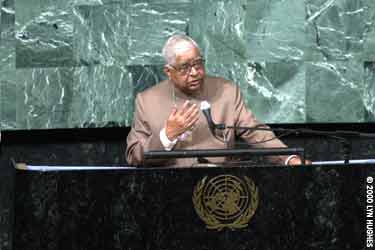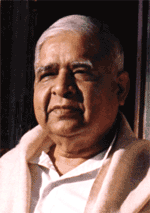S.N. Goenka uzrunā Miera samitu
Rakstījis Bils Higgins 2000.gada 29. augustā
Ņujorka – Vipassanas ačarija S.N. Goenka uzrunāja Tūkstošgades Pasaules miera samita dalībniekus, kuri šodien bija sapulcējušies Apvienoto Nāciju Organizācijas Ģenerālās asamblejas zālē. Tā ir pirmā reliģisko un garīgo līderu pulcēšanās ANO.
Goenkas kunga runa sadaļā ar nosaukumu “Konfliktu transformācija” bija vērsta uz reliģiskās harmonijas, tolerances un mierpilnas līdzāspastāvēšanas tēmām.
"Tā vietā, lai konvertētu cilvēkus no vienas organizētas reliģijas citā organizētā reliģijā," teica Goenkas kungs: "Mums vajadzētu mēģināt konvertēt cilvēkus no posta uz laimi, no jūga uz atbrīvotību un no nežēlības uz līdzjūtību."
Goenkas kungs sniedza runu samita pēcpusdienas sesijā aptuveni diviem tūkstošiem delegātu un novērotāju. Goenkas kungs runāja sesijā pēc CNN dibinātāja Ted Turner runas. Turner kungs ir viens no Samita finanšu patroniem.
Turpinot Samita tēmu par miera rašanu pasaulē, Goenkas kungs savā runā uzsvēra, ka mieru pasaulē nevar sasniegt, ja vien miera nav pašos cilvēkos. "Pasaulē nevar valdīt miers, kad cilvēku sirdīs ir dusmas un naids. Miers pasaulē ir sasniedzams tikai ar mīlestību un līdzjūtību sirdīs."
Samita darbībā svarīgi ir centieni samazināt reliģiskos konfliktus un spriedzi. Par šo Goenkas kungs sacīja: "Kad cilvēks izjūt dusmas un naidu, viņš kļūst nelaimīgs neatkarīgi no tā, vai viņš ir kristietis, hinduists vai musulmanis."
Vareniem aplausiem skanot, viņš teica: "Kuram ir mīlestības un līdzjūtības pilna šķīsta sirds, pieredz Debesu karaļvalsti sevī. Tas ir dabas likums vai, citiem vārdiem sakot, Dieva griba."
Atbilstoši pūlim, kurā atradās pasaules galvenie reliģiskie līderi, Goenka sacīja: "Ļaujiet mums koncentrēties uz kopīgo visās reliģijās, uz sirds tīrību, kas ir visu reliģiju serde. Mums visiem vajadzētu pievērst uzmanību šim reliģijas aspektam un izvairīties no konfliktiem par reliģiju čaulām, kas ir dažādi rituāli, svētki un dogmas."
Kopsavilkuma vietā Goenkas kungs citēja Imperatoru Ashoku, kurš vienā no saviem Akmens ediktiem, ir paudis: "Nevajadzētu godināt tikai savu reliģiju un nosodīt citas reliģijas. Tā vietā dažādu iemeslu dēļ vajadzētu cienīt citas reliģijas. Šādi rīkojoties, var palīdzēt plaukt savai reliģijai un pakalpot arī citām reliģijām. Savādāka rīcība ir savas reliģijas kapā rakšana un kaitēšana citām reliģijām. Dievbijības pilns kāds var godināt savu reliģiju un nosodīt citas reliģijas, domājot: "Es slavinu savu reliģiju." Bet šāda rīcība pamatīgi ievaino viņa reliģiju. Jātiecas pēc saskaņas. Ļaujiet visiem klausīties un esiet gatavi uzklausīt citu vēstītās doktrīnas."
ANO ģenerālsekretārs Kofi Annans Samitu nodēvēja par "pasaules izcilāko reliģisko un garīgo līderu pulcēšanos vienotā aicinājumā pēc miera, kas, cerams, ieejot jaunā tūkstošgadē, stiprinās izredzes uz mieru.
Uz pirmo šāda veida ANO konferenci uzaicināto vidū bija tādi garīgie līderi kā Pramukh Swami no Swami Narayana Movement, Swami Dayananda Saraswati, Swami Agniwesh, Mata Amritanandamayi Devi un Dada Wasvani, kā arī izcili zinātnieki, piemēram, Dr. Karan Singh un L.M. Singhvi.
Saistībā ar dalībnieku reliģijas un kultūras daudzveidību, Annans ir teicis: "Apvienoto Nāciju Organizācija ir gobelēns, ko veido ne tikai uzvalki un sari, bet arī garīdznieku apkakles, mūķeņu tērpi un lamu ietērpi, miteri, skufijas un jarmolkas."
Lai gan Annanu vairākkārt izjautāja par Tibetas līdera neierašanos, viņš jautājumus mēģināja saistīt ar Samita mērķiem, kas, viņa vārdiem izsakoties, ir “atjaunot reliģijas īsteno miera nesēja un uzturētāja lomu. Konflikti nerodas Bībelē, Torās vai Korānā. Patiesi, problēma nekad nav ticībā - tā ir draudzē/ticības sekotājos/ticīgajos un tajā, kā mēs izturēties vienam pret otru. Jums sev uzticīgajiem atkal ir jāmāca dzīvot mierā un iecietībā."
ANO vadība cer, ka tā kā 83% pasaules iedzīvotāju ievēro formāli reliģiskas vai garīgas uzskatu sistēmas, šie reliģiskie līderi var vedīs savus sekotājus pretim mieram.
ANO cer, ka konference virzīs pasaules sabiedrību iepretim tam, kas kādā dokumentā formulēts tā: "apliecināt savu garīgo potenciālu, un atzīt, ka tas ir mūsu pašu spēkos - izskaust cilvēku brutalitātes sliktāko veidu - karu -, kā arī vienu no kara pamatcēloņiem - nabadzību. Ir pienācis laiks pasaules garīgajai vadībai ciešāk sadarboties ar ANO tās centienos risināt cilvēces neatliekamās vajadzības."
Samits noslēgsies šo ceturtdien, 31. augustā, kad dalībnieki parakstīs Deklarāciju par mieru pasaulē un izveidos Reliģisko un garīgo līderu starptautisko konsultatīvo padomi, kas sadarbosies ar Apvienoto Nāciju Organizāciju un ANO Ģenerālsekretāru miera radīšanas un nodrošināšanas jautājumos.
"Reliģisko un garīgo līderu starptautiskās konsultatīvās padomes mērķis ir uzlabot un stiprināt Apvienoto Nāciju Organizācijas darbu," teica Bawa Jains, Pasaules miera samita ģenerālsekretārs. "Tā ir mūsu dedzīga vēlme, lai konfliktu laikā pasaules varenie reliģiskie un garīgie līderi var tikt nosūtīti uz šiem karstajiem punktiem, lai rastu nevardarbīgus konfliktu risinājumus."


